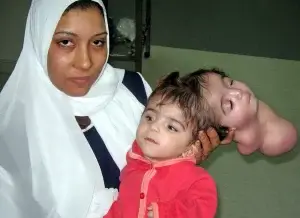The two-headed boy of Bengal was born in the village of Mundul Gait in India in 1783. According to reports, this was the first reported case of Craniopagus parasiticus, or, as many would term it, “parasitic conjoined twins.”
When the two-headed boy was born, at first sight, the midwife who assisted in the birth of the boy was horrified and then tried to kill him by throwing in fire; however, the boy was luckily saved with some burns in one eye and ear.
Growing on top of another, the boy’s second head sat inverted on top of the main head and ended in a neck-like stump covered by black hair at their junction.
Both heads were of the same size and seemed to function independently of each other. When one head cried, the other smiled. The lower head did not always influence the features of the upper one; for instance, when the child slept, the second head was awake and taking in the surroundings.
Recovering from the shock, the parents saw a money-making opportunity in him exhibiting him in Calcutta, where he attracted a great deal of attention and earned the family a fair amount of money.
To prevent the crowd from taking a peek without paying, his parents would cover him with a sheet for hours at a time. As his fame spread across India, many politicians and noblemen developed an interest. One of the noblemen who picked interest included Colonel Pierce, who described the encounter to the President of the Royal Society, Sir Joseph Banks, who later forwarded the account to the surgeon Everard Home.
The boy unfortunately died before Everard Home could meet him. He died at 4 years old after being bitten by a cobra after his mother left him alone to fetch water.
Many anatomists tried to buy the body, but the parents refused to sell it. However, Mr. Dent, a salt agent for the East Indian Company, later stole the body and sold the skull to Everard.
The skull of the boy can still be seen at the Hunterian Museum of the Royal College of Surgeons of London.
The Bengal boy’s case is an example of Craniopagus parasiticus, a rare teratological condition in which the body and the limbs of the parasitic twin are underdeveloped, leaving only a parasitic head attached to the developed twin. Parasitic twinning has occurred in about 2 to 3 of 5,000,000 births, according to the October 2010 article “Craniopagus parasiticus: A rare case” in the Journal of Clinical Neuroscience.
A handful of cases of craniopagus have been reported around the world, according to the Journal of Clinical Neuroscience, but most are stillborn or die within a few months. Those who have survived and had surgeries have only been alive for a few months. Many die from brain infections following the procedures.
The exact development of Craniopagus parasiticus is not well known. However, it is known that the underdeveloped twin is a parasitic twin. Parasitic twins are known to occur in utero when monozygotic twins start to develop as an embryo, but the embryo fails to completely split. When this happens, one embryo will dominate development while the other’s is severely altered.
Neurosurgeons have attempted surgery in the Dominican Republic, Uganda, Egypt, Romania, and Turkey, but the baby’s survival is low, and most die hours after birth.

